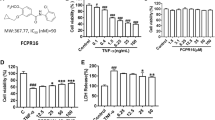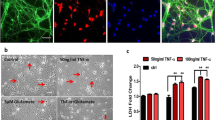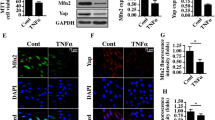Abstract
Although Homer 1, of the postsynaptic density, regulates apoptosis, the signaling mechanisms are not fully elucidated. In this study, we found that tumor necrosis factor-α (TNF-α)/cycloheximide (CHX) treatment transiently increased Homer 1a (the short variant of Homer 1), but did not affect Homer 1b/c (the long variant of Homer 1). Overexpression of Homer 1a blocked TNF-α/CHX-induced apoptotic cell death, whereas inhibition of Homer 1a induction enhanced the pro-apoptotic effect of TNF-α/CHX treatment. Moreover, brain-derived neurotrophic factor, as a potential activator of endogenous Homer 1a, inhibited apoptotic cell death after TNF-α/CHX treatment through induction of Homer 1a. Since three major mitogen-activated protein kinase (MAPK) pathways have important roles in apoptosis, we examined if Homer 1a is involved in the effects of MAPK pathways on apoptosis. It was shown that inhibition of the ERK1/2 pathway increased the expression and the protective effect of Homer 1a, but inhibition of the p38 pathway produced the opposite effect. Cross-talk among MAPK pathways was also associated with the regulation of Homer 1a during apoptotic cell death. Blocking the p38 pathway increased the activity in the ERK1/2 pathway, while inhibition of ERK1/2 pathway abolished the effect of p38 inhibitor on Homer 1a. Furthermore, Homer 1a reversely affected the activation of MAPK pathways. These findings suggest that Homer 1a plays an important role in the prevention of apoptotic cell death and contributes to distinct regulatory effects of MAPK pathways on apoptotic cell death.









Similar content being viewed by others
References
Kato A, Ozawa F, Saitoh Y, Hirai K, Inokuchi K (1997) vesl, a gene encoding VASP/Ena family related protein, is upregulated during seizure, long-term potentiation and synaptogenesis. FEBS Lett 412:183–189
Brakeman PR, Lanahan AA, O’Brien R et al (1997) Homer: a protein that selectively binds metabotropic glutamate receptors. Nature 386:284–288
Xiao B, Tu JC, Petralia RS et al (1998) Homer regulates the association of group 1 metabotropic glutamate receptors with multivalent complexes of homer-related, synaptic proteins. Neuron 21:707–716
Sun J, Tadokoro S, Imanaka T et al (1998) Isolation of PSD-Zip45, a novel Homer/vesl family protein containing leucine zipper motifs, from rat brain. FEBS Lett 437:304–308
Kato A, Ozawa F, Saitoh Y, Fukazawa Y, Sugiyama H, Inokuchi K (1998) Novel members of the Vesl/Homer family of PDZ proteins that bind metabotropic glutamate receptors. J Biol Chem 273:23969–23975
Tu JC, Xiao B, Yuan JP et al (1998) Homer binds a novel proline-rich motif and links group 1 metabotropic glutamate receptors with IP3 receptors. Neuron 21:717–726
Xiao B, Tu JC, Worley PF (2000) Homer: a link between neural activity and glutamate receptor function. Curr Opin Neurobiol 10:370–374
Sala C, Roussignol G, Meldolesi J, Fagni L (2005) Key role of the postsynaptic density scaffold proteins Shank and Homer in the functional architecture of Ca2+ homeostasis at dendritic spines in hippocampal neurons. J Neurosci 25:4587–4592
Yuan JP, Kiselyov K, Shin DM et al (2003) Homer binds TRPC family channels and is required for gating of TRPC1 by IP3 receptors. Cell 114:777–789
Fagni L, Chavis P, Ango F, Bockaert J (2000) Complex interactions between mGluRs, intracellular Ca2+ stores and ion channels in neurons. Trends Neurosci 23:80–88
Hu JH, Park JM, Park S et al (2010) Homeostatic scaling requires group I mGluR activation mediated by Homer 1a. Neuron 68:1128–1142
Ehlers MD (2002) Molecular morphogens for dendritic spines. Trends Neurosci 25:64–67
Grant SG, O’Dell TJ (2001) Multiprotein complex signaling and the plasticity problem. Curr Opin Neurobiol 11:363–368
Roloff AM, Anderson GR, Martemyanov KA, Thayer SA (2010) Homer 1a gates the induction mechanism for endocannabinoid-mediated synaptic plasticity. J Neurosci 30:3072–3081
Miletic G, Driver AM, Miyabe-Nishiwaki T, Miletic V (2009) Early changes in Homer 1 proteins in the spinal dorsal horn are associated with loose ligation of the rat sciatic nerve. Anesth Analg 109:2000–2007
Tappe A, Klugmann M, Luo C et al (2006) Synaptic scaffolding protein Homer 1a protects against chronic inflammatory pain. Nat Med 12:677–681
Huber KM, Gallagher SM, Warren ST, Bear MF (2002) Altered synaptic plasticity in a mouse model of fragile X mental retardation. Proc Natl Acad Sci USA 99:7746–7750
Govek EE, Newey SE, Akerman CJ, Cross JR, Van der Veken L, Van Aelst L (2004) The X-linked mental retardation protein oligophrenin-1 is required for dendritic spine morphogenesis. Nat Neurosci 7:364–372
Roselli F, Hutzler P, Wegerich Y, Livrea P, Almeida OF (2009) Disassembly of shank and homer synaptic clusters is driven by soluble beta-amyloid(1-40) through divergent NMDAR-dependent signalling pathways. PLoS One 4:e6011
Dickey CA, Loring JF, Montgomery J, Gordon MN, Eastman PS, Morgan D (2003) Selectively reduced expression of synaptic plasticity-related genes in amyloid precursor protein + presenilin-1 transgenic mice. J Neurosci 23:5219–5226
Knackstedt LA, Moussawi K, Lalumiere R, Schwendt M, Klugmann M, Kalivas PW (2010) Extinction training after cocaine self-administration induces glutamatergic plasticity to inhibit cocaine seeking. J Neurosci 30:7984–7992
Rezvani K, Teng Y, Shim D, De Biasi M (2007) Nicotine regulates multiple synaptic proteins by inhibiting proteasomal activity. J Neurosci 27:10508–10519
Huang WD, Fei Z, Zhang X (2005) Traumatic injury induced homer-1a gene expression in cultured cortical neurons of rat. Neurosci Lett 389:46–50
Rong R, Ahn JY, Huang H et al (2003) PI3 kinase enhancer-Homer complex couples mGluRI to PI3 kinase, preventing neuronal apoptosis. Nat Neurosci 6:1153–1161
Sakamoto K, Yoshida S, Ikegami K et al (2007) Homer 1c interacts with Hippi and protects striatal neurons from apoptosis. Biochem Biophys Res Commun 352:1–5
Shin JN, Piya S, Yun CW et al (2009) Homer 1 regulates the susceptibility to TRAIL. Exp Cell Res 315:2249–2255
Chen T, Fei F, Jiang XF et al (2012) Down-regulation of Homer 1b/c attenuates glutamate-mediated excitotoxicity through endoplasmic reticulum and mitochondria pathways in rat cortical neurons. Free Radic Biol Med 52:208–217
Wang L, Du F, Wang X (2008) TNF-alpha induces two distinct caspase-8 activation pathways. Cell 133:693–703
Park JG, Yuk Y, Rhim H, Yi SY, Yoo YS (2002) Role of p38 MAPK in the regulation of apoptosis signaling induced by TNF-alpha in differentiated PC12 cells. J Biochem Mol Biol 35:267–272
Bhattacharya S, Ray RM, Viar MJ, Johnson LR (2003) Polyamines are required for activation of c-Jun NH2-terminal kinase and apoptosis in response to TNF-alpha in IEC-6 cells. Am J Physiol Gastrointest Liver Physiol 285:G980–G991
Utreras E, Futatsugi A, Rudrabhatla P et al (2009) Tumor necrosis factor-alpha regulates cyclin-dependent kinase 5 activity during pain signaling through transcriptional activation of p35. J Biol Chem 284:2275–2284
Yamaguchi S, Tanabe K, Takai S et al (2009) Involvement of Rho-kinase in tumor necrosis factor-alpha-induced interleukin-6 release from C6 glioma cells. Neurochem Int 55:438–445
Schafers M, Svensson CI, Sommer C, Sorkin LS (2003) Tumor necrosis factor-alpha induces mechanical allodynia after spinal nerve ligation by activation of p38 MAPK in primary sensory neurons. J Neurosci 23:2517–2521
Kato A, Fukazawa Y, Ozawa F, Inokuchi K, Sugiyama H (2003) Activation of ERK cascade promotes accumulation of Vesl-1S/Homer-1a immunoreactivity at synapses. Brain Res Mol Brain Res 118:33–44
Sato M, Suzuki K, Nakanishi S (2001) NMDA receptor stimulation and brain-derived neurotrophic factor upregulate homer 1a mRNA via the mitogen-activated protein kinase cascade in cultured cerebellar granule cells. J Neurosci 21:3797–3805
Marrone DF, Schaner MJ, McNaughton BL, Worley PF, Barnes CA (2008) Immediate-early gene expression at rest recapitulates recent experience. J Neurosci 28:1030–1033
Yano M, Steiner H (2005) Methylphenidate (Ritalin) induces Homer 1a and zif 268 expression in specific corticostriatal circuits. Neuroscience 132:855–865
Potschka H, Krupp E, Ebert U et al (2002) Kindling-induced overexpression of Homer 1A and its functional implications for epileptogenesis. Eur J Neurosci 16:2157–2165
Ageta H, Kato A, Fukazawa Y, Inokuchi K, Sugiyama H (2001) Effects of proteasome inhibitors on the synaptic localization of Vesl-1S/Homer-1a proteins. Brain Res Mol Brain Res 97:186–189
Dietrich JB, Arpin-Bott MP, Kao D, Dirrig-Grosch S, Aunis D, Zwiller J (2007) Cocaine induces the expression of homer 1b/c, homer 3a/b, and hsp 27 proteins in rat cerebellum. Synapse 61:587–594
Zhao X, Cao M, Liu JJ, Zhu H, Nelson DR, Liu C (2011) Reactive oxygen species is essential for cycloheximide to sensitize lexatumumab-induced apoptosis in hepatocellular carcinoma cells. PLoS One 6:e16966
Ji Y, Lu Y, Yang F et al (2010) Acute and gradual increases in BDNF concentration elicit distinct signaling and functions in neurons. Nat Neurosci 13:302–309
Girard BM, Keller ET, Schutz KC, May V, Braas KM (2004) Pituitary adenylate cyclase activating polypeptide and PAC1 receptor signaling increase Homer 1a expression in central and peripheral neurons. Regul Pept 123:107–116
Kammermeier PJ (2008) Endogenous homer proteins regulate metabotropic glutamate receptor signaling in neurons. J Neurosci 28:8560–8567
Sharma M, Hanchate NK, Tyagi RK, Sharma P (2007) Cyclin dependent kinase 5 (Cdk5) mediated inhibition of the MAP kinase pathway results in CREB down regulation and apoptosis in PC12 cells. Biochem Biophys Res Commun 358:379–384
Tan Z, Dohi S, Chen J, Banno Y, Nozawa Y (2002) Involvement of the mitogen-activated protein kinase family in tetracaine-induced PC12 cell death. Anesthesiology 96:1191–1201
Spencer ML, Shao H, Andres DA (2002) Induction of neurite extension and survival in pheochromocytoma cells by the Rit GTPase. J Biol Chem 277:20160–20168
Stevens C, Lin Y, Sanchez M et al (2007) A germ line mutation in the death domain of DAPK-1 inactivates ERK-induced apoptosis. J Biol Chem 282:13791–13803
Cheng Y, Qiu F, Tashiro S, Onodera S, Ikejima T (2008) ERK and JNK mediate TNFalpha-induced p53 activation in apoptotic and autophagic L929 cell death. Biochem Biophys Res Commun 376:483–488
Sivaprasad U, Basu A (2008) Inhibition of ERK attenuates autophagy and potentiates tumour necrosis factor-alpha-induced cell death in MCF-7 cells. J Cell Mol Med 12:1265–1271
Cai B, Chang SH, Becker EB, Bonni A, Xia Z (2006) p38 MAP kinase mediates apoptosis through phosphorylation of BimEL at Ser-65. J Biol Chem 281:25215–25222
Gaitanaki C, Mastri M, Aggeli IK, Beis I (2008) Differential roles of p38-MAPK and JNKs in mediating early protection or apoptosis in the hyperthermic perfused amphibian heart. J Exp Biol 211:2524–2532
Zhang L, Xing D, Liu L, Gao X, Chen M (2007) TNFalpha induces apoptosis through JNK/Bax-dependent pathway in differentiated, but not naive PC12 cells. Cell Cycle 6:1479–1486
Shen YH, Godlewski J, Zhu J et al (2003) Cross-talk between JNK/SAPK and ERK/MAPK pathways: sustained activation of JNK blocks ERK activation by mitogenic factors. J Biol Chem 278:26715–26721
Li SP, Junttila MR, Han J, Kahari VM, Westermarck J (2003) p38 Mitogen-activated protein kinase pathway suppresses cell survival by inducing dephosphorylation of mitogen-activated protein/extracellular signal-regulated kinase kinase1,2. Cancer Res 63:3473–3477
Ageta H, Kato A, Hatakeyama S, Nakayama K, Isojima Y, Sugiyama H (2001) Regulation of the level of Vesl-1S/Homer-1a proteins by ubiquitin-proteasome proteolytic systems. J Biol Chem 276:15893–15897
Shiraishi-Yamaguchi Y, Furuichi T (2007) The Homer family proteins. Genome Biol 8:206
Worley PF, Zeng W, Huang G et al (2007) Homer proteins in Ca2+ signaling by excitable and non-excitable cells. Cell Calcium 42:363–371
Luo P, Chen T, Zhao Y et al (2012) Protective effect of Homer 1a against hydrogen peroxide-induced oxidative stress in PC12 cells. Free Radic Res 46:766–776
Acknowledgments
We would like to give our thanks to Ning Su, Yihui Ma, Kai Wang, Junli Huo, Juan Li, Xiaoyan Chen, and Yufen Shi for technical assistance. The work was supported by National Natural Science Foundation of China (Nos. 30670796, 30930093) and the 863 High-Tech Project (2009AA02Z419).
Author information
Authors and Affiliations
Corresponding authors
Electronic supplementary material
Below is the link to the electronic supplementary material.
Rights and permissions
About this article
Cite this article
Luo, P., Zhao, Y., Li, D. et al. Protective effect of Homer 1a on tumor necrosis factor-α with cycloheximide-induced apoptosis is mediated by mitogen-activated protein kinase pathways. Apoptosis 17, 975–988 (2012). https://doi.org/10.1007/s10495-012-0736-z
Published:
Issue Date:
DOI: https://doi.org/10.1007/s10495-012-0736-z




